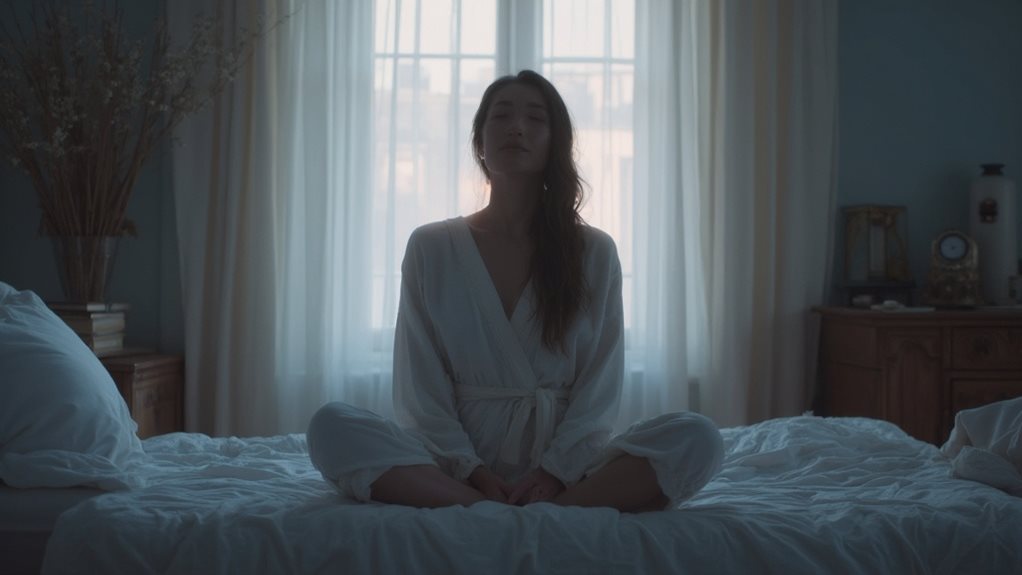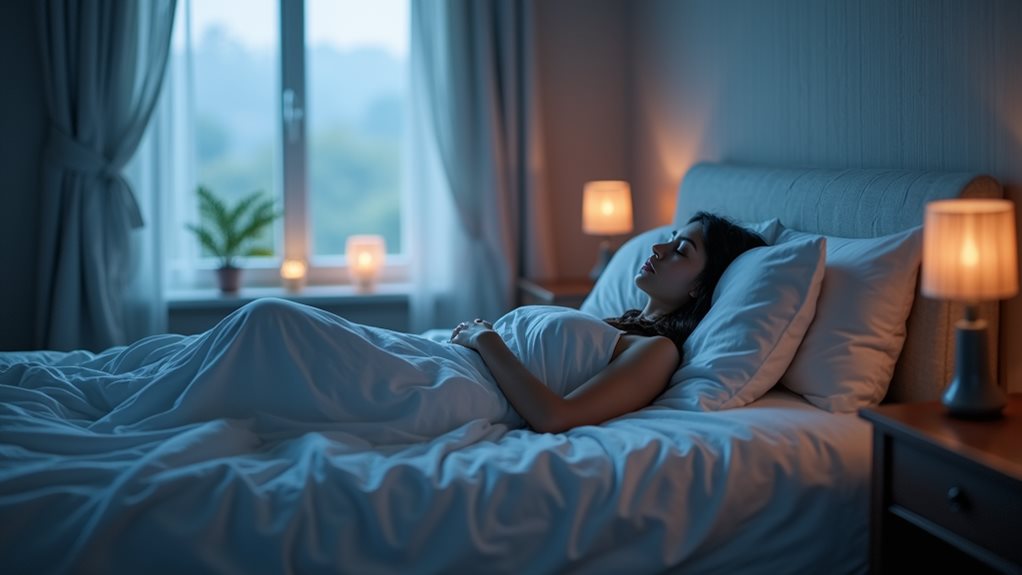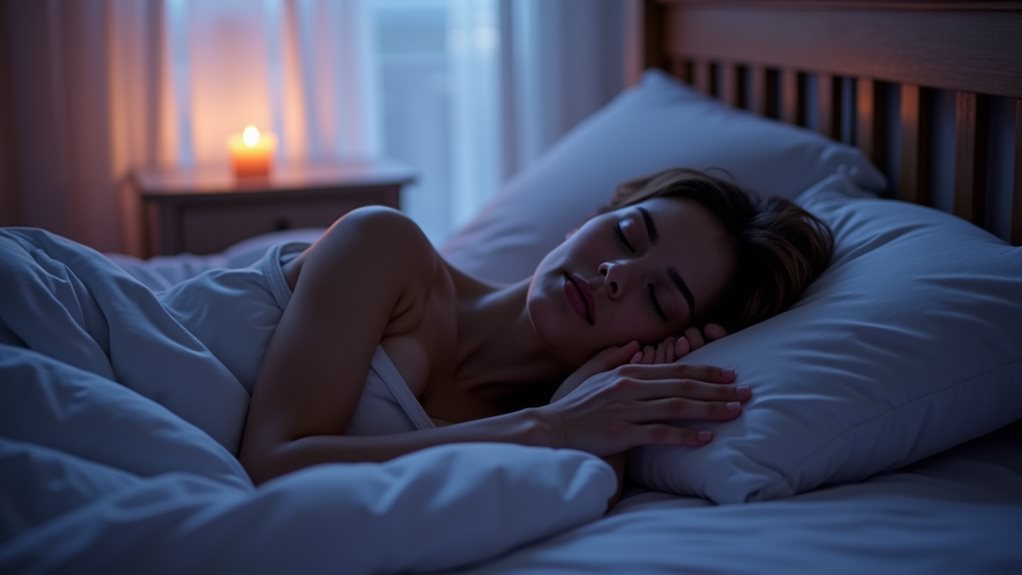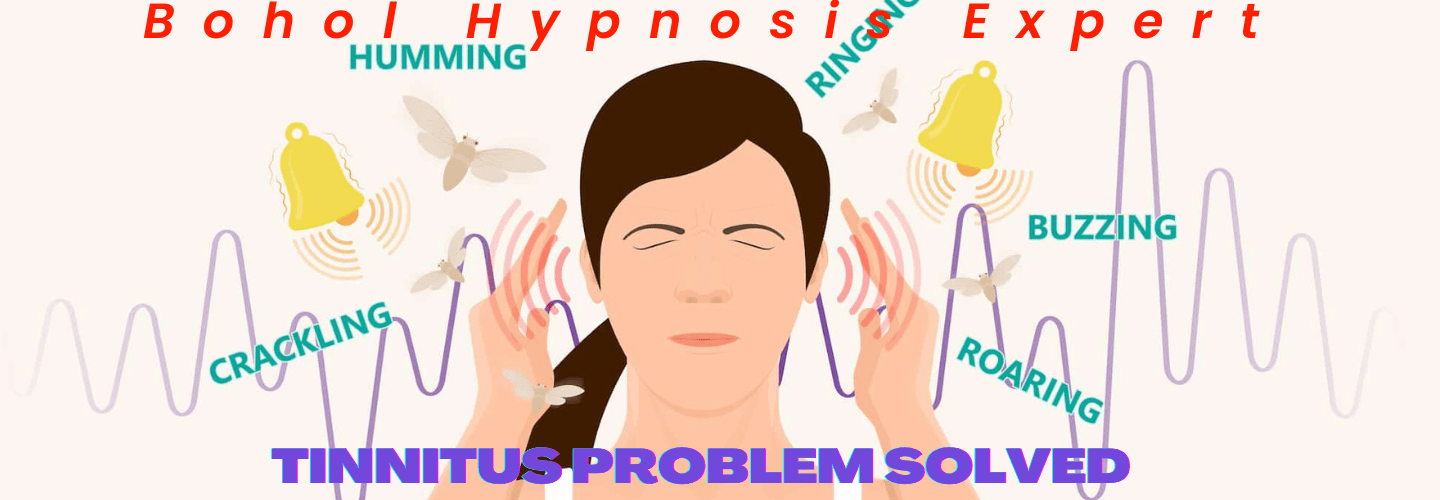
Self-hypnosis techniques, such as calming visualizations and progressive muscle relaxation, offer powerful ways to alleviate stress and guarantee a night of restful sleep. By engaging vivid mental imagery of serene landscapes or systematically relaxing muscle groups, individuals can initiate deep relaxation, conducive to sleep. Adopting these methods consistently can greatly enhance sleep quality. Incorporating such practices nightly may unveil further secrets to achieving peaceful and restorative slumber.
Key Takeaways
- Utilize visualization to imagine calming scenes, aiding in mental relaxation and readiness for sleep.
- Practice progressive muscle relaxation to systematically reduce physical tension and enhance sleep quality.
- Employ guided imagery to create peaceful mental landscapes that foster deep relaxation and sleep.
- Incorporate autogenic training to induce sensations of warmth and heaviness, promoting a relaxed state.
- Apply self-induction techniques like mindful breathing and sleep affirmations to center and prepare the mind for restful sleep.
Exploring the Power of Calming Visualizations
Why do so many people turn to calming visualizations for better sleep? Many find that envisioning serene nature scenes through visualization exercises helps quiet the mind and prepare the body for rest.
These exercises involve picturing tranquil settings such as a sunset beach or a quiet forest, which promote relaxation and reduce stress. Research supports that such mental imagery can considerably lessen anxiety, making it easier to shift into sleep.
Mastering Progressive Muscle Relaxation for Better Sleep
Many individuals find progressive muscle relaxation (PMR) to be an effective technique for alleviating insomnia and enhancing sleep quality. This method involves systematically tensing and then relaxing different muscle groups, which helps in reducing muscle tension and promoting overall relaxation.
By focusing on deep, slow breaths during each phase, PMR not only eases physical tension but also calms the mind. Regular practice of this relaxation technique before bedtime can considerably improve sleep patterns and decrease the time it takes to fall asleep.
Empowering individuals to manage their relaxation actively, PMR is a practical and beneficial approach to better sleep.
The Benefits of Guided Imagery in Achieving Deeper Sleep

After exploring the effectiveness of progressive muscle relaxation in soothing the body, it becomes clear that the mind, too, requires attention for ideal sleep.
Guided imagery serves this purpose by crafting vivid mental landscapes, inviting the mind to wander through serene scenes that foster deep relaxation. This technique is not only a journey through tranquil vistas but also a profound method for stress reduction.
Introduction to Autogenic Training for Sleep Improvement
While guided imagery effectively calms the mind, autogenic training offers a complementary approach that focuses on self-induced relaxation of the body and mind to enhance sleep quality.
This method involves autogenic relaxation techniques, where individuals focus on sensations of warmth and heaviness in various parts of the body, paired with deep, rhythmic breathing.
Mindfulness practices are integral, as they help maintain a present focus, steering thoughts away from daily stresses.
Regular practice of autogenic training can greatly improve sleep by reducing mental and physical tension, creating an ideal state for deep, restorative sleep.
This holistic approach fosters overall well-being.
Self-Induction Techniques for a Peaceful Night's Rest

Shifting from autogenic training, self-induction techniques offer additional tools to achieve a peaceful night's rest.
These methods empower individuals to actively engage in their journey towards tranquil sleep through focused self-hypnosis practices.
- Begin with Mindful Breathing: Slow, deep breaths to center the mind and body, setting a calm stage for sleep.
- Employ Sleep Affirmations: Repeat positive phrases that reinforce a sense of safety and relaxation.
- Visualize Restful Scenes: Imagine a peaceful place that soothes the senses.
- Progressive Relaxation: Tense and relax muscles sequentially to release physical stress and enhance comfort.
These steps foster a conducive environment for restorative sleep.
Frequently Asked Questions
How Long Should a Self-Hypnosis Session Last for Effective Sleep?
The ideal session duration for effective self-hypnosis varies, but typically, 20-30 minutes is recommended. This timing allows sufficient relaxation without causing excessive drowsiness, making it practical for nightly routines to enhance sleep quality.
Can Self-Hypnosis Techniques Cure Insomnia Permanently?
While self-hypnosis cannot permanently cure insomnia, it effectively addresses some underlying causes. Techniques like guided imagery and muscle relaxation benefit sleep by reducing stress, providing a practical, empathetic approach to managing symptoms of insomnia.
Are Self-Hypnosis Techniques Safe for Children to Use?
Self-hypnosis techniques are generally safe for children when practiced under adult supervision and following established hypnosis guidelines. It is essential to tailor approaches to guarantee child safety and address specific relaxation needs.
How Often Should I Practice Self-Hypnosis to See Results?
Studies suggest consistent daily practice of self-hypnosis enhances effectiveness. Frequency guidelines recommend daily sessions, emphasizing practice consistency to achieve noticeable improvements in relaxation and sleep quality within a few weeks.
Can Self-Hypnosis Interfere With REM Sleep?
Self-hypnosis generally does not interfere with REM sleep. Instead, it can enhance sleep quality by promoting relaxation and improving sleep cycles, potentially leading to more restorative sleep and better overall health.
Conclusion
As the gentle waves of the ocean rhythmically lull the shore into tranquility, so too can self-hypnosis techniques soothe the restless mind into a serene slumber. Studies suggest that individuals who practice these methods reduce their sleep onset time by up to 50%, mirroring nature's effortless sway towards calmness. Embracing these practices nightly promises not just improved sleep but a rejuvenated awakening, ready to face the day with renewed vigor and clarity.





